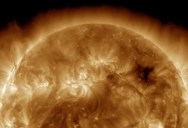Massive Solar Storm Produced Incredible Auroras, But Also Put Satellite Operators On Edge
by Michael Levanduski

If you logged onto almost any social media platform on the weekend of May 10th, 2024 you almost certainly saw something extraordinary.
Virtually all the fighting and disagreement stopped and was replaced by something amazing.
Pictures and videos of the Aurora Borealis were being posted by millions of people throughout almost all of the Northern Hemisphere.
While these auroras aren’t rare in the extreme North, they are quite infrequent in other places and almost non-existent the further South you travel.
That weekend, however, people throughout North America, Europe, and Asia all got an amazing show with some pictures coming from as far south as Texas and Florida.
For many people, myself included, this once-in-a-lifetime opportunity allowed them to check off this elusive item on their bucket list, but what was it that allowed these Northern Lights to be seen so far South, and what other impact did they have?

These auroras, like all auroras, got their start millions of miles away on the Sun.
A massive sunspot emitted large amounts of charged particles known as solar wind. When those particles interact with the Earth’s magnetic field, the atmospheric interaction can create the beautiful lights in the sky.
In addition to the amazing light show, these particles can also have some negative impact to a variety of different electrical systems on Earth, and orbiting above.
The National Oceanic and Atmospheric Administration (NOAA) reported measurable impact from this storm, though no significant damage. Shawn Dahl from the Space Weather Prediction Center at NOAA reported:
“Simply put, the power grid operators have been busy since yesterday working to keep proper, regulated current flowing without disruption.”
Satellites and spacecraft that orbit the Earth can also be impacted. Dahl said:
“Satellite operators are also busy monitoring spacecraft health due to the S1-S2 storm takign place along with the severe-extreme geomagnetic storm that continues.”
One of the sunspots that caused this solar storm was captured by one of NOAA’s satellites, and can be seen here:

While sunspots and solar storms are quite common, it is rare for them to be both this powerful and occur in an area of the sun that would allow the charged particles to impact the Earth.
Such an incredible aurora event may not be seen again in our lifetimes.
If you thought that was interesting, you might like to read about why we should be worried about the leak in the bottom of the ocean.
Categories: STORIES
Tags: · aurora borealis, northern lights, picture, science, single topic, solar storm, space, sunspot, top

Never Miss a Story
Sign up to get our BEST stories of the week straight to your inbox.




